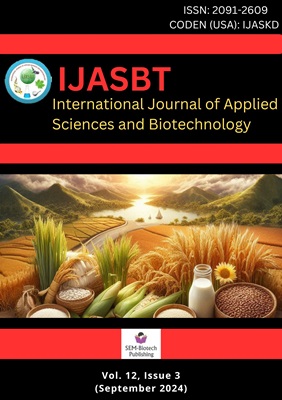Evaluation of Efficacy of Certain Pesticides and Black Plastic Mulch as an Approach of Developing Integrated Pest Management for Melon Fruit Fly (Bactrocera cucurbitae)
DOI:
https://doi.org/10.3126/ijasbt.v12i3.66540Keywords:
IPM, Bactrocera cucurbitae, Control, YieldAbstract
A field experiment was conducted at Pyuthan Municipality, Pyuthan district of the Federal Democratic Republic of Nepal to develop an integrated pest management strategy against melon fruit fly (Bactrocera cucurbitae). The experiment was laid out in two factorial Randomized Complete Block Design (RCBD). The first factor was different doses of pesticides; Spinosad (45% SC) @ 1ml/3l water, Cypermethrin (10% EC) @5ml/20l water and, botanical Jholmol @ 1:3 ratio (1 part Jholmol and 3 part water). The second factor was Black plastic mulch and no mulch. The pesticides were applied at 9 day intervals and data on fruit infestation, ovary damage, yield and, post-set damage were collected at 3 day intervals and the data analysed using R Studio. The result revealed highly significant differences among mulching and non-mulching plots. Mulching plots had the lowest fruit infestation (3.95%), lowest ovary damage (0.88%), lowest post-set damage (2.38%) and, higher yield per plot (21.25 kg) than non-mulched plots. Highest protection against melon fruit fly was observed by Spinosad at the third spray; percentage of fruit infestation (3.71%), ovary damage (0.76%) and yield (20.20 kg/plot) followed by Cypermethrin and Jholmol. The highest protection was obtained by the application of Cypermethrin (1.78%) at the post-set stage followed by Spinosad and Jholmol. The application of Spinosad, Cypermethrin alone with black plastic mulch provided superior protection than Jholmol and control. However, the pest reduction and yield observed on the treatments with the combination of Jholmol and black plastic mulch was satisfactory (21.87 kg/ha) than control (14.58 kg/ha).
Int. J. Appl. Sci. Biotechnol. Vol 12(3): 126-136.
Downloads
Downloads
Published
How to Cite
Issue
Section
License
Copyright (c) 2024 International Journal of Applied Sciences and Biotechnology

This work is licensed under a Creative Commons Attribution-NonCommercial 4.0 International License.




